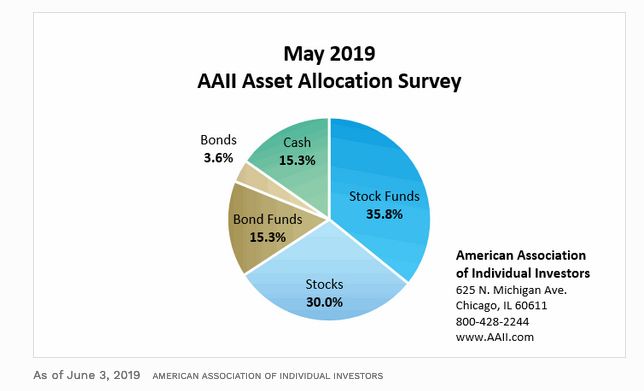As the U.S.-China trade deal that was supposed to happen went south, investors increased their exposure to fixed income to a point where it reached a six-year high based on the latest AAII Asset Allocation Survey.
As such, other notable trends included a decreased exposure to equities and an increase of investors sitting on the sidelines with cash.
Other highlights:
- Allocations to stocks and associated funds declined 2.0 percentage points to 65.8 percent
- Equity allocations remain above their historical average of 61.0 percent for the 74th consecutive month
- Bond and bond fund allocations rose 1.8 percentage points to 18.9 percent
- Fixed-income allocations were last higher in April 2013 (19.7 percent)
- May was the fourth time in five months with bond and bond fund allocations above their historical average of 16.0 percent

Fixed Income: The Q1 Comeback Kid
This latest data could provide insight on a repeat performance of fixed income’s first quarter. It’s no doubt that the volatility-laden fourth quarter of 2018 spurred an investor move to bonds, but that trend persisted in the first quarter of 2019 with $34.5 billion going into fixed income exchange-traded funds (ETFs), according to a US-Listed Flash Flows Report from State Street Global Advisors.
“While equity funds took in the most flows last month, bond funds are now breaking records and making headlines,” wrote Matt Bartolini, Head of SPDR Americas Research at State Street Global Advisors. “Fixed income ETFs have taken in $34.5 billion to start the year, the highest flow total ever for a first quarter, narrowly beating out the hot start to 2016.
“The $34.5 billion represents an increase of 5.2% of fixed income ETFs start-of-year assets. If bond funds are able to maintain this pace, it would lead to over $130 billion of fund flows–a figure that would represent new all-time record and likely push total assets over $800 billion for the first time.”
 As opposed to simply adding a broad-based fund like the iShares Core US Aggregate Bond ETF (NYSEArca: AGG), it will take more of a strategic bent, such as looking into actively-managed funds or other corners of the bond market like municipal debt. This is especially so since the Federal Reserve said during its fourth and final rate hike in December 2018 that it will do more reassessing–the central bank already lowered its forecast to no rate hikes in 2019 as opposed to the initial two forecasted.
As opposed to simply adding a broad-based fund like the iShares Core US Aggregate Bond ETF (NYSEArca: AGG), it will take more of a strategic bent, such as looking into actively-managed funds or other corners of the bond market like municipal debt. This is especially so since the Federal Reserve said during its fourth and final rate hike in December 2018 that it will do more reassessing–the central bank already lowered its forecast to no rate hikes in 2019 as opposed to the initial two forecasted.
Where are the opportunities in fixed income at the moment? Bartolini identified some notable trends.
“Within fixed income, they’re (investors) are actually buying high yield, investment-grade quality bonds,” Bartolini told ETF Trends. “What they’re doing essentially is going overweight fixed income, overweight credit and basically changing their risk within a portfolio–trading equity risk for credit risk, and credit has similar equity returns, but with less volatility.”
For more market trends, visit ETF Trends and to access up-to-date data on ETFs, visit ETFdb.com.

